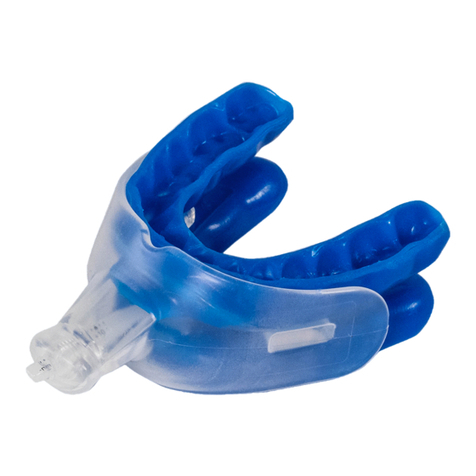
Trouble Shooting
Seal is uncomfortable or leaks
Condensation or Whistling
If you experience whistling sounds or excessive condensation In your
mask you may need to turn down your humidifier. Do this gradually,
over a few nights to avoid reducing the humidity too much.
Your Morf Nasal Mask may be disconnected from the main CPAP Tube
by disassembling the Swivel Connector. It is easiest to assemble and
disassemble the Swivel Connector at an angle.
Cleaning Your Mask
Weekly:
Hand wash the Headgear following the same procedure as above.
Warning:
Do not wash the mask in the dishwasher.
Do not clean the mask with products that contain chlorine, bleach,
moisturiser, antiseptic, anti-bacterial agents or alcohol.
Note: Failure to follow the cleaning instructions may compromise the
performance and safety of the mask.
Disposal:
Your mask be disposed of in the general waste.
Technical Specifications
Bias Flow Graph
Bias Flow Data
Resistance to flow
Drop in pressure (through mask at given flow rate)
- At 50 L/min 0.14 cm H20
- At 100 L/mom 0.56 cm H2O
Materials
The Morf nasal mask is Silicone and Latex free.
Mask Dead Space
70 mL (the physical dead space is the empty volume of the mask to
the end of the swivel)
Sound
Sound Power Level 23.7 dBA
Sound Pressure Level 15.7 dBA
Service Life
Service life is dependent on the care, maintenance, intensity of
usage and environmental conditions in which the mask is used in
and stored.
Morf Nasal Mask (Headgear)
Part Number 80000
Morf Nasal Mask (No Headgear)
Part Number 80001
Morf Headgear
Part Number 80002
Morf Swivel
Part Number 80003
Spare Parts
Mask
Pressure
(cm H20)
Vent Flow
Rate
(L/min)
8 27
12 33
18 40
20 42
0
5
10
15
20
25
30
35
40
45
4 6 8 10 12 14 16 18 20
Exhaust Flow (L/min)
Pressure (cm H20)
Exhaust Flow
Fitting Your Mask
Fitting Your Seal
The first step to fitting your mask is to fit the seal to your face.
This process can be repeated using the same seal to adjust the fit
as necessary. (Please read these instructions in full before starting
to fit your seal.)
Place boiling water into a bowl.
Holding the mask by the
flexible tube, place the white
mask Seal into the bowl for 60
seconds. (ensure that the white
Seal is entirely submerged and
all white areas turn clear, including the upper lip region and
ensure the tube is not placed in the hot water)
Shake any excess hot water o the Seal and wait 30 seconds for
the seal to cool.
Lying on your back place the Seal on your nose, with the tube
pointing down.
Gently press the mask against your face so the mask touches
your upper lip and the forehead support comes close to, or
touches, your forehead.
Keep the mask still, while lying on your back for 5 minutes while
the Seal cools and sets to the shape of your face. Once it turns
completely white everywhere it has set.
Remove the mask from your face and reconnect the headgear.
Fitting Your Nasal Mask
1.
2.
3.
4.
5.
6.
7.
8.
Place your mask on your face and adjust all four headgear
straps to secure the mask on your face. This is best done lying
down in your common sleeping position.
Connect your mask to your CPAP machine, turn the machine on
and test the fit of your mask.
Adjust the headgear straps to prevent any air leaking between
the mask and your face.
Increasing tension on the lower straps is the best way to
eliminate leaks.
1.
2.
3.
4.
After each use:
Remove the remove the Headgear.
Place the Mask in lukewarm water that contains a mild soap.
Note: Do not soak for more than 10 minutes.
Remove the mask components and rinse them thoroughly in
fresh water, ensuring that all soap residue is removed.
Leave all parts to dry out of direct sunlight.
1.
2.
3.
4.
If you have a wide nose you may want flare your nose during the seal
fitting process to widen the mask Seal.
Or widen the seal with your fingers before placing on your nose
during the Seal fitting process
Or place ear plugs in your nose during seal fitting to widen the seal.
If this cannot be eliminated by headgear adjustment you can reheat
and refit the seal to get a better fit to your face.
You can do this as many times as you like.
You can even reheat only the part of the seal you want to refit.
Try refitting the mask and ensure that you are lying you’re your back
and do not move the mask during the 5 minute cooling period.
When refitting your seal you may want to gently press on the region
that was leaking or needs reshaping.
You may find using a fabric mask liner such as RemZzz’s® may
improve the comfort and seal.
Mask movement
If you find your mask moves and leaks please ensure that the
forehead support is touching your forehead.
You will need to reheat and fit the seal of the forehead support is
not touching your forehead.
Wide nose
•
•
•
•
•
•
•
•
•
•
•
Remove the headgear from the mask.
Using Your Swivel Connector




















